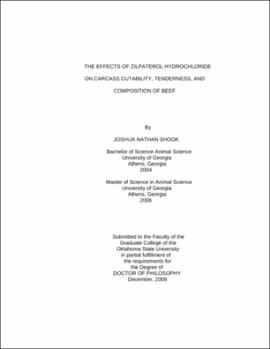| dc.contributor.advisor | VanOverbeke, Deb | |
| dc.contributor.author | Shook, Joshua Nathan | |
| dc.date.accessioned | 2013-11-26T08:22:39Z | |
| dc.date.available | 2013-11-26T08:22:39Z | |
| dc.date.issued | 2009-12 | |
| dc.identifier.uri | https://hdl.handle.net/11244/6624 | |
| dc.description.abstract | Scope and Method of Study: Beta-agonists are compounds similar to the natural catecholamines found in the body and are currently being used to improve the efficiency of gain and lean production in livestock. Zilpaterol hydrochloride (ZH) (Intervet/Schering Plough, Millsboro, DE) is the most recently approved beta-agonist for use in the U.S. beef cattle industry. Zilpaterol hydrochloride is marketed as a compound that will improve the growth efficiency, lean production, and carcass weight of fed cattle. The objectives of this study were to determine the impact of ZH on carcass cutability and tenderness of beef steers as well as calf-fed Holstein steers. Beef carcasses (n = 127) and calf-fed Holstein carcasses (n = 102) were selected from cattle fed either 8.3 mg/kg/d (DM basis) or 0 mg/kg of ZH during the final 20 d of the finishing period. Carcasses were fabricated into subprimals according to the National Meat Processors Association (NAMP). All steaks were randomly assigned to either 14 or 21 d aging period prior to WBS determination. Strip loins from beef steers and strip loins, bottom rounds, and top rounds from the calf-fed Holstein steers were collected for Warner-Bratzler shear force analysis (WBS). Subprimals collected from calf-fed Holstein steers were assigned to control or enhancement treatment. Thaw loss, cook loss, and chill loss were recorded during the cooking of steaks for WBS determination. | |
| dc.description.abstract | Findings and Conclusions: Wholesale carcass lean was increased (P < 0.001) from both beef and calf-fed Holsteins supplemented with ZH. Furthermore, in both sets of steers, subprimals from the hindquarter seemed to have a greater response to ZH treatment than subprimals from the forequarter. Zilpaterol hydrochloride also decreased (P < 0.01) the amount of total bone and fat trim in calf-fed Holsteins and decreased (P = 0.05) total bone in beef steers. Tenderness was decreased (P < 0.05) in all steaks tested from ZH supplemented carcasses when compared to control carcasses. However, enhancement improved (P < 0.05) tenderness in strip loin, bottom round, and top round steaks when compared to non-enhanced steaks. Additionally, enhanced strip loin and top round steaks had less (P < 0.05) cook loss during cooking when compared to non-enhanced steaks. These results indicated that ZH is very effective at improving lean carcass yields in both beef and calf-fed Holstein steers. Furthermore, ZH has a negative impact on tenderness, but, enhancement improved beef tenderness and may be used to address tenderness issue in animals fed ZH. | |
| dc.format | application/pdf | |
| dc.language | en_US | |
| dc.rights | Copyright is held by the author who has granted the Oklahoma State University Library the non-exclusive right to share this material in its institutional repository. Contact Digital Library Services at lib-dls@okstate.edu or 405-744-9161 for the permission policy on the use, reproduction or distribution of this material. | |
| dc.title | Effects of zilpaterol hydrochloride on carcass cutability, tenderness, and composition of beef | |
| dc.contributor.committeeMember | Hilton, Gretchen | |
| dc.contributor.committeeMember | DeWitt, Christina | |
| dc.contributor.committeeMember | Step, D. L. | |
| osu.filename | Shook_okstate_0664D_10586.pdf | |
| osu.accesstype | Open Access | |
| dc.type.genre | Dissertation | |
| dc.type.material | Text | |
| thesis.degree.discipline | Food Science | |
| thesis.degree.grantor | Oklahoma State University | |
